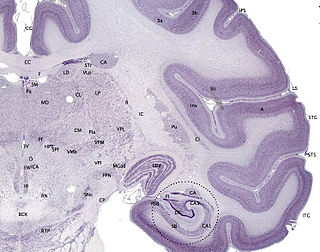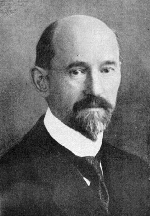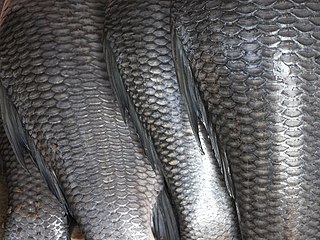
The retina is the innermost, light-sensitive layer of tissue of the eye of most vertebrates and some molluscs. The optics of the eye create a focused two-dimensional image of the visual world on the retina, which translates that image into electrical neural impulses to the brain to create visual perception, the retina serving a function analogous to that of the film or image sensor in a camera.

The cerebral cortex, also known as the cerebral mantle, is the outer layer of neural tissue of the cerebrum of the brain, in humans and other mammals. It is separated into two cortices, by the longitudinal fissure that divides the cerebrum into the left and right cerebral hemispheres. The two hemispheres are joined beneath the cortex by the corpus callosum. The cerebral cortex is the largest site of neural integration in the central nervous system. It plays a key role in memory, attention, perception, awareness, thought, language, and consciousness.

A Brodmann area is a region of the cerebral cortex, in the human or other primate brain, defined by its cytoarchitecture, or histological structure and organization of cells.

Korbinian Brodmann was a German neurologist who became famous for his definition of the cerebral cortex into 52 distinct regions from their cytoarchitectonic (histological) characteristics, known as Brodmann areas.

The neocortex, also called the neopallium and isocortex, is the part of the mammalian brain involved in higher-order brain functions such as sensory perception, cognition, generation of motor commands, spatial reasoning and language.

In anatomy of animals, the archicortex or archipallium is the phylogenetically oldest region of the brain's pallium or cortex.

Pick's disease is a specific pathology that is one of the causes of frontotemporal lobar degeneration. It is also known as Pick disease and PiD. A defining characteristic of the disease is build-up of tau proteins in neurons, accumulating into silver-staining, spherical aggregations known as "Pick bodies". Common symptoms that are noticed early are personality and emotional changes, as well as deterioration of language.
The allocortex is one of the two types of cerebral cortex, the other being the neocortex. It is characterized by having just three or four cell layers, in contrast with the six layers of the neocortex, and takes up a much smaller area than the neocortex. There are three subtypes of allocortex: the paleocortex, the archicortex, and the periallocortex – a transitional zone between the neocortex and the allocortex.

The paralimbic cortex is an area of three-layered cortex that includes the following regions: the piriform cortex, entorhinal cortex, the parahippocampal cortex on the medial surface of the temporal lobe, and the cingulate cortex just above the corpus callosum.

In neuroanatomy, pallium refers to the layers of grey and white matter that cover the upper surface of the cerebrum in vertebrates. The non-pallial part of the telencephalon builds the subpallium. In basal vertebrates the pallium is a relatively simple three-layered structure, encompassing 3-4 histogenetically distinct domains, plus the olfactory bulb. It used to be thought that pallium equals cortex and subpallium equals telencephalic nuclei, but it has turned out, according to comparative evidence provided by molecular markers, that the pallium develops both cortical structures and pallial nuclei, whereas the subpallium develops striatal, pallidal, diagonal-innominate and preoptic nuclei, plus the corticoid structure of the olfactory tuberculum. In mammals, the cortical part of the pallium registers a definite evolutionary step-up in complexity, forming the cerebral cortex, most of which consists of a progressively expanded six-layered portion isocortex, with simpler three-layered cortical regions allocortex at the margins. The allocortex subdivides into hippocampal allocortex, medially, and olfactory allocortex, laterally.

A fish scale is a small rigid plate that grows out of the skin of a fish. The skin of most fishes is covered with these protective scales, which can also provide effective camouflage through the use of reflection and colouration, as well as possible hydrodynamic advantages. The term scale derives from the Old French "escale", meaning a shell pod or husk.

The line of Gennari is a band of myelinated axons that run parallel to the surface of the cerebral cortex on the banks of the calcarine fissure in the occipital lobe. This formation is visible to the naked eye as a white strip running through the cortical grey matter, and is the reason the primate V1 is also referred to as "striate cortex." The line of Gennari is due to dense axonal input from the thalamus to layer IV of visual cortex. The structure is named for its discoverer, Francesco Gennari, who first observed it in 1776 as a medical student at the University of Parma. He described it in a book which he published six years later. Although non-primate species have areas that are designated primary visual cortex, some lack a stria of Gennari.
Agranular insula is a portion of the cerebral cortex defined on the basis of internal structure in the human, the macaque, the rat, and the mouse. Classified as allocortex (periallocortex), it is in primates distinguished from adjacent neocortex (proisocortex) by absence of the external granular layer (II) and of the internal granular layer (IV). It occupies the anterior part of the insula, the posterior portion of the orbital gyri and the medial part of the temporal pole. In rodents it is located on the ventrolateral surface of the cortex rostrally, between the piriform area ventrally and the gustatory area or the visceral area dorsally.
Mesocortex is the transitional areas of the cerebral cortex, formed at borders between true isocortex and true allocortex. Parts of mesocortex that lie closer to the true isocortex and have more resemblance to the isocortex in their cytoarchitectonics and histology, are called proisocortex. Parts of mesocortex that lie closer to the true allocortex and have more resemblance to the allocortex in their cytoarchitectonics and histology, are called periallocortex.

Anatomical terminology is used to describe microanatomical structures. This helps describe precisely the structure, layout and position of an object, and minimises ambiguity. An internationally accepted lexicon is Terminologia Histologica.
The neomammalian brain is one of three aspects of Paul MacLean’s Triune Theory of the human brain. MacLean was an American physician and neuroscientist that formulated his model in the 1960s, which was published in his own 1990 book ‘The Triune Brain in Evolution’ 2. MacLean’s three-part theory explores how the human brain has evolved from ancestors over millions of years, consisting of the reptilian, paleomammalian and neomammalian complexes. 25 MacLean proposes that the neomammalian complex is only found in higher order mammals,4 for example, the human brain, accounting for increased cognitive ability such as motor control, memory, improved reasoning and complex decision making 1










